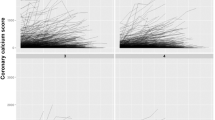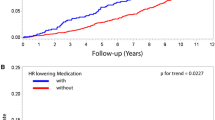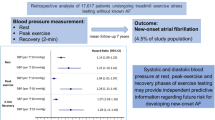Abstract
We tested whether slower heart rate recovery (HRR) following graded exercise treadmill testing (GXT) was associated with the presence of coronary artery calcium (CAC). Participants (n = 2,648) ages 18–30 years at baseline examination underwent GXT, followed by CAC screening 15 years later. Slow HRR was not associated with higher odds of testing positive (yes/no) for CAC at year 15 (OR = 0.99, p = 0.91 per standard deviation change in HRR). Slow HRR in young adulthood is not associated with the presence of CAC at middle age.
Similar content being viewed by others
Introduction
The prognostic value of slow heart rate recovery (HRR) after exercise in predicting cardiovascular disease (CVD) events has been established [5, 11, 12, 13, 15]. Initial increases in heart rate with exercise are due to parasympathetic withdrawal while sympathetic activation is responsible for heart rates greater than a 100 beats/minute. In the first two minutes following cessation of exercise, the rapid decrease in heart rate is principally determined by parasympathetic reactivation [1, 8]. Although slow HRR is associated with less autonomic nervous system responsiveness, the underlying mechanisms linking slow HRR to increased cardiovascular morbidity are not well understood. It is possible that slow HRR is associated with a higher susceptibility for atherosclerosis. Prior studies of patients referred for cardiac angiography for suspected ischemic heart disease (IHD) suggest an association between slow HRR and higher atherosclerotic burden [15]. Further, slow HRR has been observed to be associated with several risk factors for atherosclerosis [2, 3, 10]. However, the relationship between HRR and atherosclerosis in the general population has not been studied using a prospective study design. In a cohort of healthy young adults, we investigated whether slow HRR following a graded exercise treadmill test (GXT) was associated with the presence of coronary artery calcium (CAC), a marker of subclinical atherosclerosis, when assessed 15 years later.
Methods and statistical analysis
The Coronary Artery Risk Development in Young Adults study (CARDIA) is a longitudinal study designed to investigate the origins of cardiovascular disease in young adulthood [6]. Beginning in 1985, 5,115 African-American and Caucasian individuals [(African-American (52%) and women (54%)] ages 18–30 were recruited at sites in Birmingham, Alabama; Chicago, Illinois; Minneapolis, Minnesota; and Oakland, California. All participants gave informed consents prior to enrollment.
At baseline, a symptom-limited maximal GXT was administered using the Balke protocol [14]. The test included nine 2-minute stages of increasing difficulty with participants encouraged to exercise to exhaustion, followed by a recovery period at a speed of 3.2 km/hour at 0% grade. HRR was defined as the difference between the maximum HR and HR at 2-minutes into recovery [10]. Participants were ineligible for exercise testing if they were on cardioactive medications, had a resting systolic or diastolic pressure >160 or >100 mmHg, or were febrile at time of examination. The rate of energy expenditure for the completion GXT was estimated and reported in metabolic equivalents (METs), as previously described [14]. Information on physical activity was collected by interview using a standardized questionnaire.
At the year 15 follow-up examination, returning participants (n = 3,043) underwent coronary artery computed tomography (CT) scanning for the measurement of CAC. Mean HRR did not differ between those who did and did not return to the year 15 examination (42.8 versus 42.5 bpm, respectively; p = 0.55). Details of the scanning procedures have been described elsewhere [4]. Briefly, using standardized protocols, two scans were obtained for each participant (1–2 minutes apart) using electron beam CT scanners at the Chicago and Oakland sites and multidetector-row CT scanners at the Birmingham and Minneapolis sites. Calcium scores were calculated across each coronary artery and then summed across all the arteries. The final CAC score of positive scans was calculated as the mean of the two CAC scores obtained from each of the scans.
Participants were sequentially excluded from this analysis for the following reasons: use of medications that affect heart rate (HR) (n = 27), unavailable GXT or CAC data (n = 661), missing data on blood pressure, lipids, glucose, or smoking (n = 353), pregnancy (n = 27) or those absent at the year 15 exam (n = 1,399). Following exclusions, 2,648 participants remained.
Baseline characteristics were compared across sex-specific HRR tertiles. For continuous variables, test for linear trend was performed with HRR as a continuous variable using linear regression models. The Cochran-Armitage test was used to check for linear trend in binomial proportions across the HRR categories. Next, logistic regression was used to estimate the odds of the presence of CAC (defined as a CAC score >0) in relation to year 0 HRR (independent variable). HRR was modeled both as a continuous variable and in tertiles (fastest HRR tertile as the reference). Statistical significance was determined at P < 0.05. All analyses were conducted using SAS version 9.1 (SAS Institute Inc, Cary, NC).
Results
Demographic characteristics of the study sample, by 2-minute HRR tertiles, are presented in Table 1. Mean 2-minute HRR (standard deviation) for men and women were 44.3 (11.4) and 41.7 (11.5) bpm, respectively. Participants with slower HRR had less favorable GXT performance characteristics, a higher resting heart rate (both at year 0 and year 15) and reported less physically activity (both at year 0 and year 15).
The prevalence of CAC in the study sample was 9.0% (n = 239). Mean HRR at year 0 did not differ between those who had positive CAC scores versus those who had a CAC score of 0 at year 15 (42.8 bpm, for both). The unadjusted odds ratio (OR) for having a CAC score >0 for those in the slowest HRR tertile compared to those in the fastest HRR tertile was not significantly greater than 1.00 (Table 2). Similar findings were observed when HRR was studied as a continuous variable.
In secondary analysis, similar findings were observed when the presence of higher CAC burden (defined as a score >100 [n = 34]) was studied, as well as when quartiles or quintiles of 2-minute HRR were analyzed. Lastly defining HRR at 1-minute into recovery also did not result in any association between HRR and CAC.
Conclusion
Slower HRR in young adulthood is not associated with the presence of CAC when assessed 15 years later in middle age (average age 40 years). Moreover, mean HRR at baseline did not differ between those with and without measurable CAC at year 15. While previous studies have examined the relationship of HRR with CAD events this study is first to investigate the relationship of HRR with a measure of subclinical atherosclerosis.
Slow HRR has been associated with higher incident all-cause mortality, sudden cardiac death (SCD), and CVD events; however, the underlying mechanisms that link these relationships together are not known [5]. Morshedi-Meibodi et al. [12] using data from the Framingham Heart Study (FHS) observed slow HRR to be associated with coronary heart disease events (defined as acute coronary syndromes or SCD), suggesting a possible relationship between slow HRR and ischemic processes. Similarly, slow HRR has been observed to be associated with several risk factors for atherosclerosis [2, 3, 10]. In contrast to findings from the FHS, Jouven et al. [9] observed slow HRR to be related only to SCD and not death from myocardial infarction. Due to over lapping and discrepancy in clinical end points used in prior HRR studies, it cannot be determined whether slow HRR is associated with atherosclerosis or an increased susceptibility to lethal cardiac arrhythmias.
The ability of coronary CT to assess the global burden of atherosclerosis in young adults is uncertain, and CAC is only a subset of atherosclerosis, representing calcified plaques which tend to be more stable than their lipid-rich counterparts [7]. Despite these limitations, our study suggests that slow HRR in young adulthood is not related to subclinical atherosclerosis at middle age, which supports the hypothesis that slow HRR is associated with mechanisms related to cardiac arrhythmia rather than atherosclerosis.
References
Arai Y, Saul JP, Albrecht P, Hartley LH, Lilly LS, Cohen RJ, Colucci WS (1989) Modulation of cardiac autonomic activity during and immediately after exercise. Am J Physiol 256:H132–H141
Carnethon MR, Jacobs DR Jr, Sidney S, Liu K; CARDIA study (2003) Influence of autonomic nervous system dysfunction on the development of type 2 diabetes: the CARDIA study. Diabetes care 26:3035–3041
Carnethon MR, Jacobs DR Jr, Sidney S, Sternfeld B, Gidding SS, Shoushtari C, Liu K (2005) A longitudinal study of physical activity and heart rate recovery: CARDIA, 1987–1993. Med Sci Sports Exerc 37:606–612
Carr JJ, Nelson JC, Wong ND, McNitt-Gray M, Arad Y, Jacobs DR Jr, Sidney S, Bild DE, Williams OD, Detrano RC (2005) Calcified coronary artery plaque measurement with cardiac CT in population-based studies: standardized protocol of Multi-Ethnic Study of Atherosclerosis (MESA) and Coronary Artery Risk Development in Young Adults (CARDIA) study. Radiology 234:35–43
Chaitman BR (2003) Abnormal heart rate responses to exercise predict increased long-term mortality regardless of coronary disease extent: the question is why? J Am Coll Cardiol 42:839–841
Cutter GR, Burke GL, Dyer AR, Friedman GD, Hilner JE, Hughes GH, Hulley SB, Jacobs DR Jr, Liu K, Manolio TA, Savage P, Sidney S, Wagenknecht L (1991) The CARDIA baseline monograph. Control Clin Trials 12:1S–77S
Greenland P, Kizilbash MA (2005) Coronary computed tomography in coronary risk assessment. J Cardiopulm Rehabil 25:3–10
Imai K, Sato H, Hori M, Kusuoka H, Ozaki H, Yokoyama H, Takeda H, Inoue M, Kamada T (1994) Vagally mediated heart rate recovery after exercise is accelerated in athletes but blunted in patients with chronic heart failure. J Am College Cardiol 24:1529–1535
Jouven X, Empana JP, Schwartz PJ, Desnos M, Courbon D, Ducimetiere P (2005) Heart-rate profile during exercise as a predictor of sudden death. N Engl J Med 352:1951–1958
Kizilbash MA, Carnethon MR, Chan C, Jacobs DR Jr, Sidney S, Liu K (2006) The temporal relationship between heart rate recovery immediately after exercise and the metabolic syndrome: the CARDIA Study. Eur Heart J 27:1592–1596
Mora S, Redberg RF, Sharrett AR, Blumenthal RS (2005) Enhanced risk assessment in asymptomatic individuals with exercise testing and Framingham risk scores. Circulation 112:1566–1572
Morshedi-Meibodi A, Larson MG, Levy D, O’Donnell CJ, Vasan RS (2002) Heart rate recovery after treadmill exercise testing and risk of cardiovascular disease events (The Framingham Heart Study). Am J Cardiol 90:848–852
Nishime EO, Cole CR, Blackstone EH, Pashkow FJ, Lauer MS (2000) Heart rate recovery and treadmill exercise score as predictors of mortality in patients referred for exercise ECG. JAMA 284:1392–1398
Sidney S, Haskell WL, Crow R, Sternfeld B, Oberman A, Armstrong MA, Cutter GR, Jacobs DR, Savage PJ, Van Horn L (1992) Symptom-limited graded treadmill exercise testing in young adults in the CARDIA study. Med Sci Sports Exerc 24:177–183
Vivekananthan DP, Blackstone EH, Pothier CE, Lauer MS (2003) Heart rate recovery after exercise is a predictor of mortality, independent of the angiographic severity of coronary disease. J Am Coll Cardiol 42:831–838
Acknowledgments
Dr Kizilbash was supported by a National Research Service Award, NIH/NHLBI post doctoral training fellowship (T32 HL069771). Dr. Carnethon was supported in part by a career development award from the NHLBI/NIH (5 KOI HL73249-02). This study was supported by grants and contracts from the NHLBI (N01-HC-48047, N01-HC-48048, N01-HC-48049, N01-HC-48050, N01-HC-95095).
Author information
Authors and Affiliations
Corresponding author
Rights and permissions
Open Access This is an open access article distributed under the terms of the Creative Commons Attribution Noncommercial License ( https://creativecommons.org/licenses/by-nc/2.0 ), which permits any noncommercial use, distribution, and reproduction in any medium, provided the original author(s) and source are credited.
About this article
Cite this article
Kizilbash, M.A., Carnethon, M.R., Chan, C. et al. The association of heart rate recovery immediately after exercise with coronary artery calcium: the coronary artery risk development in young adults study. Clin Auton Res 17, 46–49 (2007). https://doi.org/10.1007/s10286-006-0391-y
Received:
Accepted:
Published:
Issue Date:
DOI: https://doi.org/10.1007/s10286-006-0391-y




